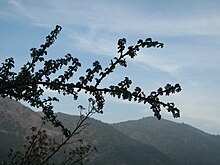
Jubaea is a genus of palms with one species, Jubaea chilensis, commonly known in English as the Chilean wine palm or Chile cocopalm, and palma chilena in Spanish. It is native to southwestern South America and is endemic to a small area of central Chile between 32°S and 35°S in southern Coquimbo, Valparaíso, Santiago, O'Higgins, and northern Maule regions.
Tiltil or Til-Til is a Chilean municipality and city, in the Chacabuco Province, Santiago Metropolitan Region. Tiltil is most known for being an execution place for rebels during Chile's independence war against Spain. Manuel Rodríguez was executed in Tiltil.

La Campana National Park is in the Cordillera de la Costa, Quillota Province, in the Valparaíso Region of Chile. La Campana National Park and the Vizcachas Mountains lie northwest of Santiago. This national park covers approximately 80 square kilometres (31 sq mi) and is home to one of the last palm forests of Jubaea chilensis, which prehistorically had a much wider distribution than at present. Another attraction is the Cerro La Campana, which lends its name to the park. In 1834 Charles Darwin climbed this mountain, during the second voyage of HMS Beagle.
La Campana-Peñuelas is a Biosphere Reserve located in west-central Chile. which includes La Campana National Park and the Lago Peñuelas National Reserve. Forests within the La Campana-Peñuelas are habitats for the Chilean Wine Palm, Jubaea chilensis, an endangered palm, which had a much broader distribution prior to modern times.

Limarí River is a river of Chile located in the Coquimbo Region. The river is formed at the confluence of the Hurtado and Grande rivers, about 4 km east of the city of Ovalle. The lower course of the river borders the southern portion of Bosque de Fray Jorge National Park. This watershed includes presence of the endangered Chilean Wine Palm, Jubaea chilensis, which prehistorically had a much broader distribution, but presently is threatened by the expanding human population in central Chile.

Paschalococos disperta, the Rapa Nui palm or Easter Island palm, formerly Jubaea disperta, was the native coccoid palm species of Easter Island. It disappeared from the pollen record circa AD 1650.

Palm syrup is an edible sweet syrup produced from the sap of a number of palms. It is produced in the Canary Islands and coastal regions of South America.
The Vizcachas Mountains is a mountain range northwest of Santiago, in the Santiago Metropolitan Region, Chile. It is part of the Chilean Coast Ranges System.
The Ocoa Valley is a landform in central Chile located by the La Campana National Park. This valley is a locus where considerable archaeological recovery has taken place, yielding considerable finds of pre-European contact period. According to Dallman and Hogan, some of the greatest stands of the endangered Chilean Wine Palm, Jubaea chilensis are found on the slopes of La Campana that rise up from the Ocoa Valley.
Adiantum gertrudis is a threatened species of ferns in the Vittarioideae subfamily of the Pteridaceae that occurs in central South America. One locus of occurrence of A. gertrudis is within central Chile at the La Campana National Park. A morphological trait unique to A. gertrudis is the hairs covering its fronds.
Puya coquimbensis is a species in the family Bromeliaceae. This species is a rare plant found in certain portions of Chile including Punta Teatinos and Cerro La Campana. In La Campana National Park P.coquimbensis is associated with the endangered Chilean Wine Palm, Jubaea chilensis, which palm prehistorically had a much wider distribution.

Puya venusta is a species of flowering plant in the family Bromeliaceae. This species is a rare plant endemic to certain areas of Chile including Punta Teatinos and Cerro La Campana. In La Campana National Park, P. venusta is associated with the endangered Chilean Wine Palm, Jubaea chilensis, a palm that prehistorically had a significantly wider distribution.

Porlieria is a genus of flowering plants in the caltrop family, Zygophyllaceae. Species within this genus are shrubs or small trees of dry subtropical regions. The generic name honours Spanish ambassador Don Antonio Porlier de Baxamar.
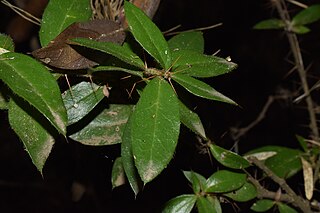
Dasyphyllum excelsum is a species of flowering plant in the family Asteraceae. This species is endemic to Chile, occurring from Quillota to Cauquenes between 190 and 800 m above sea level, a specific location of occurrence being in central Chile within the Cerro La Campana forests in association with the endangered Chilean wine palm, Jubaea chilensis.
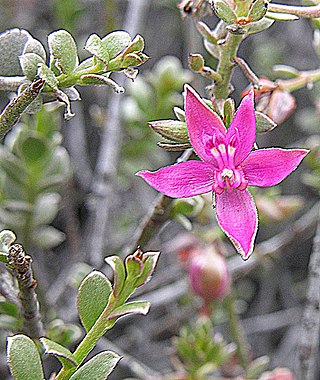
Krameria cistoidea is a perennial shrub in the plant family Krameriaceae. The biological action of genus members is caused by the astringent rhataniatannic acid, which is similar to tannic acid. Members of Krameria are found across the Americas, with most native to the tropical regions. An example occurrence is in the Cerro La Campana of central Chile, where it is found in association with the Chilean Wine Palm, Jubaea chilensis. They are perennial shrubs which act as root parasites on other plants. The flowers have glands called elaiophores which produce a lipid which is collected by bees of the genus Centris as they pollinate the flowers.
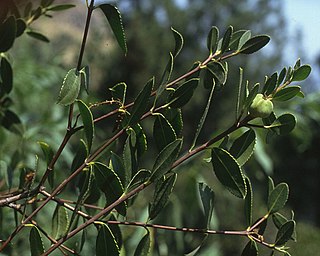
Colliguaja odorifera is a lignotuberous species of the family Euphorbiaceae. Occurrence is in portions of South America, specifically in the Chilean matorral, where it can be found on both south and north-facing slopes. Each of these slopes have different air and soil moisture levels as well as different amounts of sunlight exposure, to which the shrub is able to adapt. Its specific occurrence is noted in central Chile in the La Campana National Park and Cerro La Campana areas, where this lignotuber is found in the same forest as the endangered Chilean Wine Palm, Jubaea chilensis.
Retanilla trinervia is a species of actinorhizal plant within the family Rhamnaceae; this dicotyledon flora is a shrub or small tree. R. trinervia is notable for its ability to fix nitrogen. This species mainly occurs in the near coastal forests and arid shrubland of Chile. Example occurrences are found in the mountains of central Chile; for example, it occurs in the La Campana National Park in association with Acacia caven and Jubaea chilensis. as well as other proximate areas of central Chile.
Adesmia resinosa is a species of flowering plant in the legume family, Fabaceae. It belongs to the subfamily Faboideae. The species is found in portions of South America, with an example location being La Campana National Park in central Chile as an understory associate of the Chilean wine palm.
Myrceugenia correifolia is a species of evergreen woody flowering shrub belonging to the Myrtle family, Myrtaceae. The common name of this plant is petrillo. The species is native to South America; an example occurrence is in central Chile within the La Campana National Park.
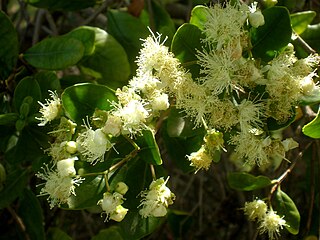
Myrceugenia exsucca is an evergreen woody flowering plant species of the Myrtle family, Myrtaceae. The species is native to South America as far south as Chile. An example occurrence is in central Chile within the La Campana National Park. A common name for this tree is petra.
